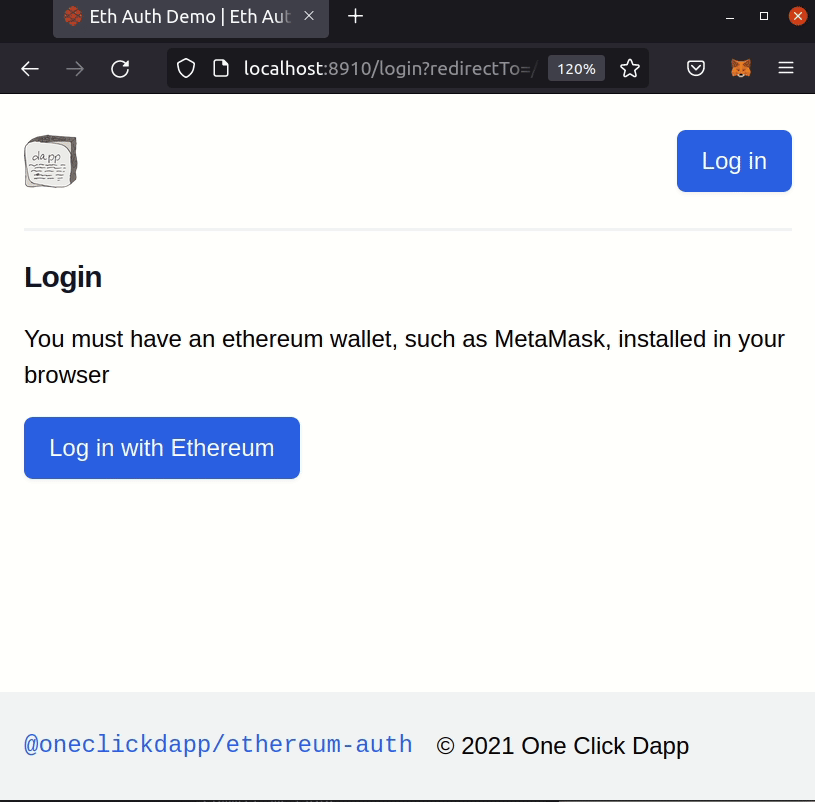Ethereum wallet login provider for RedwoodJS projects
See source code in /examples
If this is your first time using Redwood Auth, you should first familiarize yourself with how Redwood authentication works.
Create a new redwood app:
yarn create redwood-app myDappSee my introductory blog post for more help getting started.
First let's do some scaffolding and install the necessary packages. This is where the 🧙♂️✨ magic happens!
cd myDapp
yarn rw setup auth ethereum --forceUntil Redwood PR #3337 has been released, the CLI command above won't add two files. You'll need to add these manually to your project for now:
- https://github.com/oneclickdapp/ethereum-auth/blob/master/examples/eth-auth-demo/api/src/graphql/authDetails.sdl.js
- https://github.com/oneclickdapp/ethereum-auth/blob/master/examples/eth-auth-demo/api/src/services/ethereumAuth/ethereumAuth.js
You should now have a new ethereumAuth service and sdl files, and a few new dependencies (including this package). If you're curious how the auth service works, check out api/src/services/ethereumAuth/ethereumAuth.js
Next we need to update our models. Add address to the User model, and create a new AuthDetail model:
// api/db/schema.prisma
model User {
id String @id @default(uuid())
address String @unique
authDetail AuthDetail @relation(fields: [authDetailId], references: [id])
authDetailId String unique
}
model AuthDetail {
id String @id @default(uuid())
nonce String
timestamp DateTime @default(now())
User User?
}Now lets use the generator for our user model.
yarn rw generate scaffold userAwesomesauce! Let's spin up our database and apply the changes:
yarn rw prisma migrate devWe're almost there! Create a server secret for issuing jwt tokens:
yarn rw g secret
# or
openssl rand -base64 48Use the resulting string for ETHEREUM_JWT_SECRET in your .env file.
And don't forget to update your Redwood.toml for including the environment variables in your hosted app.
[web]
includeEnvironmentVariables = ['ETHEREUM_JWT_SECRET', 'DATABASE_URL', 'INFURA_ID']Webpack V5 no longer injects some node modules automatically, which are required by the @walletconnect dependencies. To fix this issue, you must add them manually to the webpack config in your RedwoodJS app.
Want to help out by removing this extra step? The
@walletconnectV5 update issue is waiting for a champion!
If you haven't run this command already, create the config file:
yarn rw setup webpackThen add the following to your config in web/config/webpack.config.js:
const webpack = require("webpack");
// See https://github.com/WalletConnect/walletconnect-monorepo/issues/584
config.resolve.fallback = {
os: require.resolve(`os-browserify/browser`),
https: require.resolve(`https-browserify`),
http: require.resolve(`stream-http`),
stream: require.resolve(`stream-browserify`),
util: require.resolve(`util/`),
url: require.resolve(`url/`),
assert: require.resolve(`assert/`),
crypto: require.resolve(`crypto-browserify`)
};
config.plugins.push(
new webpack.ProvidePlugin({
process: "process/browser",
Buffer: ["buffer", "Buffer"]
})
);Now install the missing 8 packages:
cd web
yarn add stream-browserify stream-http crypto-browserify https-browserify os-browserify util url assertTest the app builds properly in development and production
yarn rw dev
# It works in development? Great!
yarn rw buildDone! You're ready to start using your shiny new Ethereum auth just like any other RedwoodJS auth provider.
Start your RedwoodJS app:
yarn rw devHere's a quick snippet to help get you started. Check out the /examples folder for more.
// web/src/pages/LoginPage/LoginPage.js
import { Link, routes, navigate } from "@redwoodjs/router";
import { useAuth } from "@redwoodjs/auth";
import { useParams } from "@redwoodjs/router";
const LoginPage = () => {
const { logIn } = useAuth();
const { redirectTo } = useParams();
const onLogin = async () => {
await logIn();
navigate(redirectTo || routes.home());
};
return (
<>
<h1>LoginPage</h1>
<p>
You must have an ethereum wallet, such as MetaMask, installed in your
browser
</p>
<button onClick={onLogin}>Log in with Ethereum</button>
</>
);
};
export default LoginPage;You must pass at least one value rpc or infuraId to use Wallet Connect.
ethereum = new EthereumAuthClient({
makeRequest,
// Note: you must set NODE_ENV manually when using Netlify
debug: process.NODE_ENV !== "development",
infuraId: process.env.INFURA_ID
// For rpc see https://docs.walletconnect.org/quick-start/dapps/web3-provider#provider-options
});Specify the wallet type by passing a String to logIn()
const { logIn, logOut, getCurrentUser } = useAuth()
const onClickWalletConnect = async () => {
await logIn({type: "walletConnect"})Note: Don't forget to update Redwood.toml if you add new environment variables
Now that you've completed setup, you might find these resources useful. More docs/examples are welcome here!
- Tutorial II Role-based access control (RBAC) https://redwoodjs.com/tutorial2/role-based-authorization-control-rbac
- Cookbook RBAC https://redwoodjs.com/cookbook/role-based-access-control-rbac
In this repo link and watch files:
yarn link
yarn watchThen in your app, use the local linked package
yarn link @oneclickdapp/ethereum-authIf you're changes affect how internal stuff in RedwoodJS uses this package, then you'll need to do a bit more work. Things that may be affected include decoders in @redwoodjs/api, frontend tooling in @redwoodjs/auth, and CLI generators in @redwoodjs/cli. Unfortunately, yarn link will not work for redwood local development. Please follow the guide here https://github.com/redwoodjs/redwood/blob/main/CONTRIBUTING.md#local-development for more help.
# In the redwood repo
yarn build:watch
# Then in your example redwood app
yarn rwt copy:watch ../redwood- Add support for
walletconnect - Add ethereum-auth the redwood (auth playground)[https://github.com/redwoodjs/playground-auth]
- Allow direct access to the ethers
provideron the client. - Better error handling when wallet signing fails
- Export typescript types here for the user object, instead of declaring them inside
@redwoodjs/auth - Add support for
walletlink
yarn publish --dry-run- Looking to implement your own custom Redwood Auth? You may find this tutorial helpful (it may be out-dated by now)
- Redwood Tutorial: getting started and complete overview guide.
- Redwood Docs: using the Redwood Router, handling assets and files, list of command-line tools, and more.
- Redwood Redwood Community: get help, share tips and tricks, and collaborate on everything about RedwoodJS.
👤 Patrick Gallagher blockchainbuddha@gmail.com
- Website: https://patrickgallagher.dev
- Twitter: @pi0neerpat
- GitHub: @pi0neerpat
Give a ⭐️ if this project helped you!
This README was generated with ❤️ by readme-md-generator

